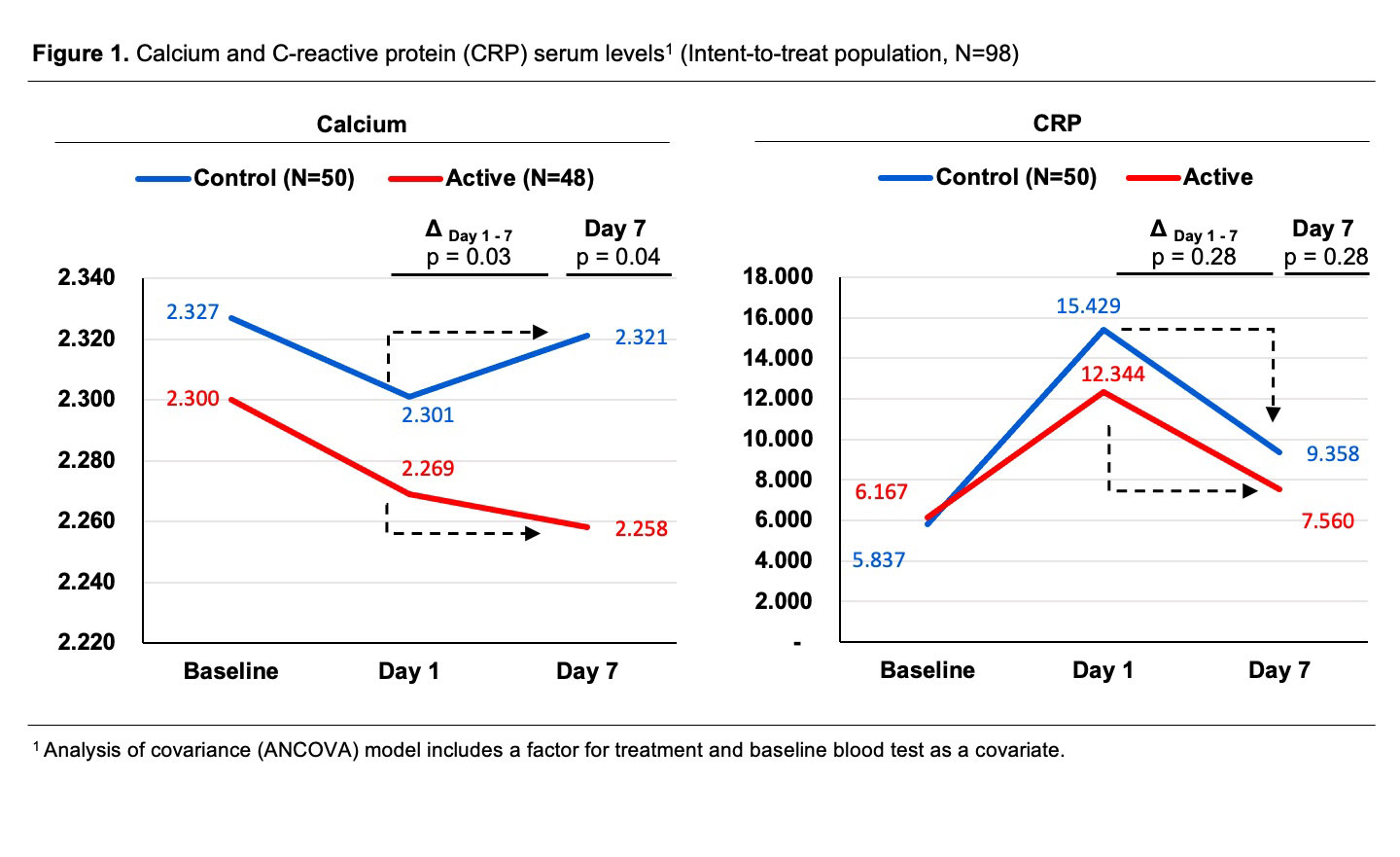Session Information
Date: Monday, November 14, 2022
Title: Metabolic and Crystal Arthropathies – Basic and Clinical Science Poster
Session Type: Poster Session D
Session Time: 1:00PM-3:00PM
Background/Purpose: Inflammatory cytokine-mediated bone resorption increases serum calcium (Ca2+) and can lead to calcification at chronically inflamed sites. Ca2+ influences cytokine activity to intensify the inflammatory response1. Ca2+regulation by the parathyroid calcium-sensing receptor (CaSR) is influenced by extracellular pH. At higher pH, CaSR is more sensitive to Ca2+ levels2 thus lowers both PTH and Ca2+. The purpose of this study was to determine if a topically applied pH modulator (sodium bicarbonate, NaHCO₃), engineered to raise the joint microenvironment pH, could effectively and safely reduce inflammatory pain and concomitantly decrease Ca2+ and C-Reactive Protein (CRP) in gout.
Methods: A Phase 2a double-blind, randomized, placebo-controlled study enrolled 418 subjects at 20 US sites. Patients who met ACR/EULAR criteria for gout (Score ≥ 8), ages 18-75, history of ≥ 2 flares in the prior year, and on stable urate lowering therapy were included. Exclusions were BMI > 40kg/m2, > 12 flares in the prior year, history of rheumatoid arthritis, psoriatic arthritis, evidence of septic arthritis, acute polyarticular gout (≥ 4 joints), and arthritis due to other causes. Upon a flare subjects took colchicine (1.2 mg + 0.6 mg at 1hr) and based on randomization, applied either placebo lotion or transdermal NaHCO₃ to the limb of the affected joint. Outcome measures included overall response rate (50% reduction in pain using pain-numeric rating scale, NRS, 0-10), rescue medication use and physical function (PROMIS PF-20). Data were collected in patient diaries for pain and PROMIS measures at several timepoints from baseline through Day 7, as were adverse events. Labs were collected at screening, Days 1 and 7. Statistical analyses utilized ANCOVA with baseline values as a covariate and two-proportion z-test, all with α=0.05.
Results: A total of 98 subjects had a gout flare during the 14-month study period. The active arm (N=48) demonstrated an overall response rate of 94.5% by Day 7 compared to 79.3% (p=0.01) in the controls (N=50). Rescue medication use was significantly lower in the active arm compared to control (6.3% vs 20.0%, p=0.02) and PROMIS PF-20 improved notably as well (22.2 vs 16.7, p=0.03).
Serum Ca2+ decreased in the NaHCO₃ arm but increased in the controls (-0.011 vs +0.020, p=0.03) from Day 1 to Day 7. These levels stayed lower for the NaHCO₃ arm (2.258 vs 2.321 mmol/L, p=0.04) at Day 7. Similarly, CRP was lower at Day 1 and Day 7 in the NaHCO₃ arm vs control, however, did not reach significance.
Although hypertension was a common adverse event (14.2%), no significant differences were noted between arms.
Conclusion: Transdermal NaHCO₃ significantly reduced acute gout pain as demonstrated by substantially higher response rates, reduced rescue medication use, and improved physical function. The significant decrease in serum Ca2+, and trend towards lower CRP, are consistent with an anti-inflammatory mechanism of action. This topical pH modulator is a promising therapeutic choice for acute gout management and potentially has broader applicability in chronic inflammatory conditions particularly where Ca2+ homeostasis is involved.
1Klein Biomolecules. 2018
2Quinn Journal of Biological Chemistry 2004
To cite this abstract in AMA style:
Khanna P, Beal R. The Impact of Topically Applied pH Modulator on Acute Inflammatory Pain, Serum Calcium, and C-Reactive Protein (CRP) During an Acute Gout Flare – a Phase 2a Randomized, Double-Blind, Placebo-Controlled Study [abstract]. Arthritis Rheumatol. 2022; 74 (suppl 9). https://acrabstracts.org/abstract/the-impact-of-topically-applied-ph-modulator-on-acute-inflammatory-pain-serum-calcium-and-c-reactive-protein-crp-during-an-acute-gout-flare-a-phase-2a-randomized-double-blind-placebo-c/. Accessed .« Back to ACR Convergence 2022
ACR Meeting Abstracts - https://acrabstracts.org/abstract/the-impact-of-topically-applied-ph-modulator-on-acute-inflammatory-pain-serum-calcium-and-c-reactive-protein-crp-during-an-acute-gout-flare-a-phase-2a-randomized-double-blind-placebo-c/


